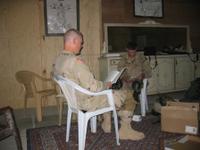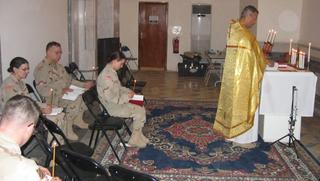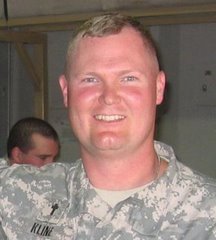 "Army of One" is not only a recruiting campaign tool; it is an ideal for which all committed soldiers strive. It is not, however, nor will it ever be, a firm reality. Yet it remains one of the most noble efforts of those who call themselves free. The larger an institution, the more it struggles with the tension of competing loyalties. In successful marriages, couples are able to mitigate most of these tensions.
"Army of One" is not only a recruiting campaign tool; it is an ideal for which all committed soldiers strive. It is not, however, nor will it ever be, a firm reality. Yet it remains one of the most noble efforts of those who call themselves free. The larger an institution, the more it struggles with the tension of competing loyalties. In successful marriages, couples are able to mitigate most of these tensions.  Most extended families have rifts and divisions that result in some level of disharmony or disunity. The United States Army is about 1.2 million strong (700,000 of which are national guard and reserve), and represents men and women ages 17 to 60 from every imaginable cultural and religious background. Although cultural sensitivity is not the first quality that comes to mind when one thinks of soldiers and war, a great deal of policy making, training, and resourcing on the part of the Army confirms mutual respect is a fundamental value to mission success: hence "respect" is one of the seven Army Values. (These first two pictures as well as the last are of an Easter Sunrise Service conducted at FOB Dagger on the cliffs of the Tigris River. In addition to the beauty of the scene, I found the image of machine guns and the celebration of Christ's new life reflective of the troublesome clash between ideals and realities. Chaplain Nordstrom, my brigade chaplain, is conducting the service for our soldiers.)
Most extended families have rifts and divisions that result in some level of disharmony or disunity. The United States Army is about 1.2 million strong (700,000 of which are national guard and reserve), and represents men and women ages 17 to 60 from every imaginable cultural and religious background. Although cultural sensitivity is not the first quality that comes to mind when one thinks of soldiers and war, a great deal of policy making, training, and resourcing on the part of the Army confirms mutual respect is a fundamental value to mission success: hence "respect" is one of the seven Army Values. (These first two pictures as well as the last are of an Easter Sunrise Service conducted at FOB Dagger on the cliffs of the Tigris River. In addition to the beauty of the scene, I found the image of machine guns and the celebration of Christ's new life reflective of the troublesome clash between ideals and realities. Chaplain Nordstrom, my brigade chaplain, is conducting the service for our soldiers.) The chaplain corps is one of the Army's most effective resources in guaranteeing this value is maintained. As chaplains, one of our fundamental duties is to either perform OR provide for the religious needs of our soldiers, their families, and Department of Defense civilians.
The chaplain corps is one of the Army's most effective resources in guaranteeing this value is maintained. As chaplains, one of our fundamental duties is to either perform OR provide for the religious needs of our soldiers, their families, and Department of Defense civilians.  I am to perform those services that are in harmony with my own religious convictions and the standards of my ecclesiastical endorser. Everything else, I am to provide through other means and resources available, i.e. connect soldiers with chaplains who can perform needed services. (These second two pictures are of Latter-day Saint services. They help illustrate the principle that all soldiers' religious needs are valued--whether there are many soldiers or just one.)
I am to perform those services that are in harmony with my own religious convictions and the standards of my ecclesiastical endorser. Everything else, I am to provide through other means and resources available, i.e. connect soldiers with chaplains who can perform needed services. (These second two pictures are of Latter-day Saint services. They help illustrate the principle that all soldiers' religious needs are valued--whether there are many soldiers or just one.)
 While in theater, I have had the opportunity of assisting our Catholic, Orthodox, Seventh-day Adventist, Jewish, and Muslim soldiers. Whenever possible, I accompany these soldiers to show my and our commander's support of their constitutionally protected religious rights. (The picture above is of a special forces chaplain, who is also a Russian Orthodox priest. He is conducting an Orthodox Easter service, enjoyed by one of my Russian soldiers. I was fascinated with the service and all its candles and insence. I really dug the ornate gold robe he wore over his desert camouflage uniform. The following picture is of one of my Jewish soldiers who traveled a good distance to FOB Anaconda to observe the Seder meal with other Jewish soldiers north of Baghdad.) Soldiers' interest in religious support is higher near the beginning and the end of deployments, but there are also those who are consistent throughout.
While in theater, I have had the opportunity of assisting our Catholic, Orthodox, Seventh-day Adventist, Jewish, and Muslim soldiers. Whenever possible, I accompany these soldiers to show my and our commander's support of their constitutionally protected religious rights. (The picture above is of a special forces chaplain, who is also a Russian Orthodox priest. He is conducting an Orthodox Easter service, enjoyed by one of my Russian soldiers. I was fascinated with the service and all its candles and insence. I really dug the ornate gold robe he wore over his desert camouflage uniform. The following picture is of one of my Jewish soldiers who traveled a good distance to FOB Anaconda to observe the Seder meal with other Jewish soldiers north of Baghdad.) Soldiers' interest in religious support is higher near the beginning and the end of deployments, but there are also those who are consistent throughout. 
The chapel I currently work at has a masjid or prayer room for our Muslim soldiers, although about 90% of those who attend juma prayers are third country nationals: civilian contractors from Southest Asia and Western Africa. Now that it is Ramadan, we are seeing them even more regularly. I haven't found a tasteful way to capture pictures of this event--but I will soon.

No comments:
Post a Comment